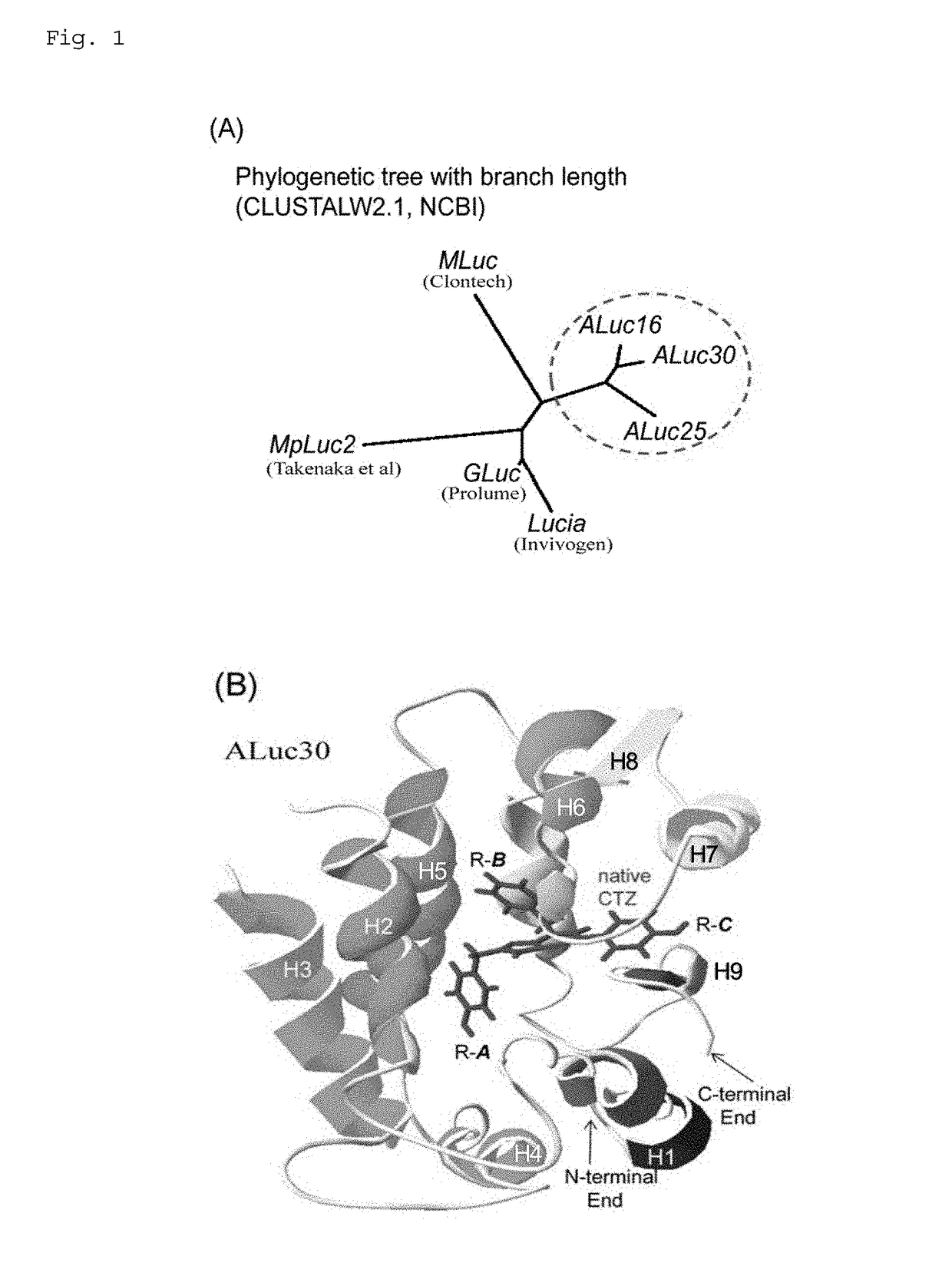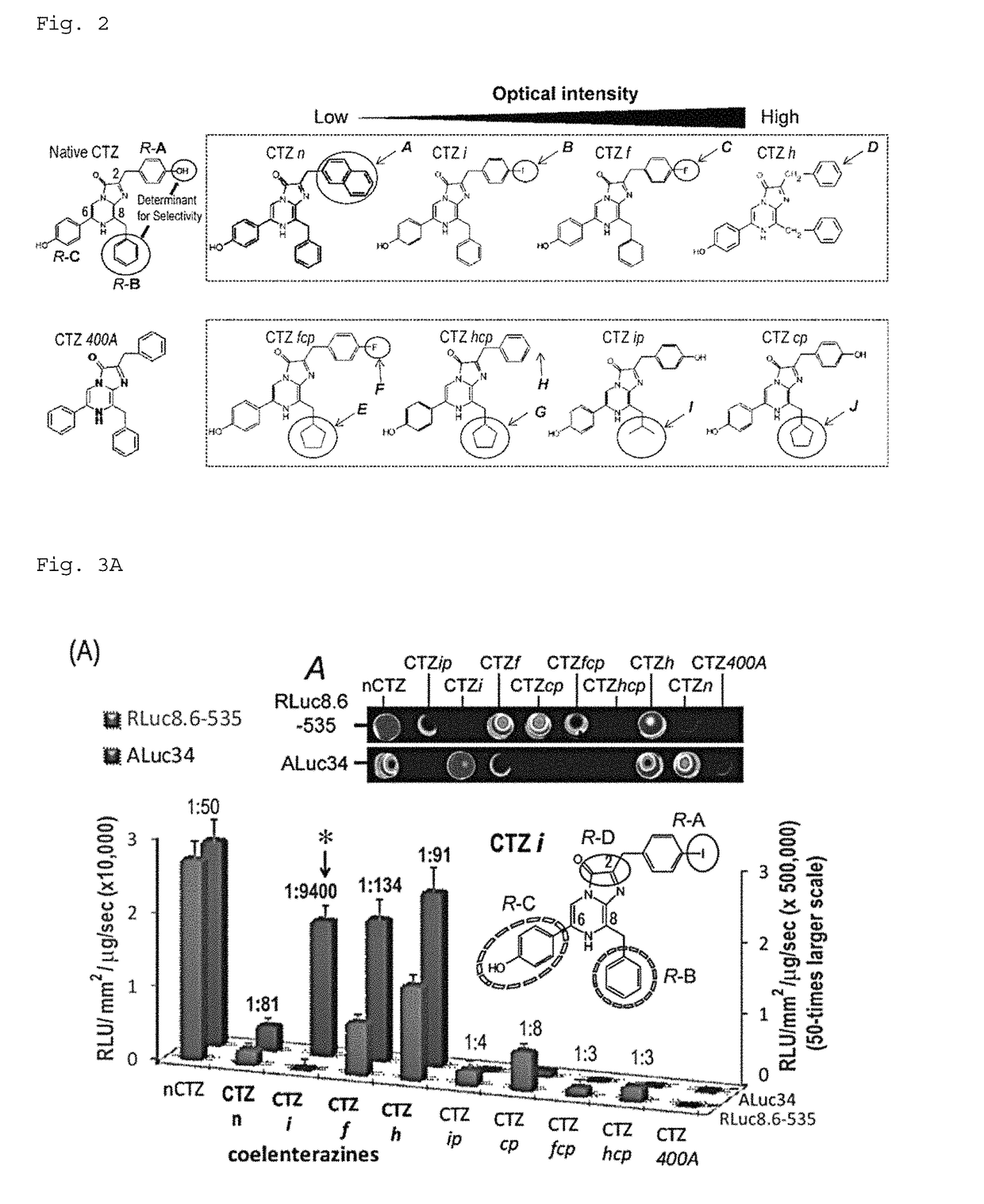Luminescent substrate for use in artificial bioluminescent enzyme
a technology of bioluminescent enzyme and substrate, which is applied in the field of bioluminescent substrate, can solve the problems of fluorescence imaging, the number of simultaneously observed, and the maturation of fluorescence chromophores taking at least several hours to several days, and achieves high luminescence intensity, high substrate selectivity, and the effect of preventing crosstalk between signals
- Summary
- Abstract
- Description
- Claims
- Application Information
AI Technical Summary
Benefits of technology
Problems solved by technology
Method used
Image
Examples
example 1
Phylogenetic Characteristics and Steric Structure of Artificial Bioluminescent Enzyme
[0249]Although a series of artificial bioluminescent enzymes (ALuc) were synthesized as disclosed in the patent application earlier filed by the present inventors, the details of a luminescent substrate specific to ALuc have not been unveiled. Thus, the inventors first elucidated the genetic correlation between ALuc and other bioluminescent enzymes from the phylogenetics perspective.
[0250]Using CLUSTALW2.1, a multiple sequence alignment program for amino acid sequences provided by the National Center for Biotechnology Information (NCBI) in the United States, the sequence of ALuc was compared with those of Metridia longa luciferase (MLuc), Metridia pacifica luciferase 2 (MpLuc2), Gaussia luciferase (GLuc), and Lucia, which are typical marine animal-derived bioluminescent enzymes and are common in the use of coelenterazine as a substrate. The results revealed as shown in FIG. 1(A) that the sequence of...
example 2
Chemical Structure of Coelenterazine Derivatives
[0254]Based on the steric structure of ALuc revealed by Example 1, a study was conducted to find an appropriate chemical structure of coelenterazine derivatives that matches the steric structure (FIG. 2). FIG. 2 shows the chemical structure of native coelenterazine in the upper-left part. The upper part lists the chemical structures with the focus on the functional group of residue A (R-A). The lower part lists the chemical structures with the main focus on the functional group of residue B (R-B). The circles and arrows are added to show the difference of residues and functional groups.
[0255]Coelenterazine consists of an imidazole frame structure and three resides bound to the imidazole structure (herein, “R-A,”“R-B,” and “R-C”). The specificity of luciferases appears to be attributed to the structure of the residues and their functional groups.
[0256]In native coelenterazine, the R-A and R-C sites have a phenol structure, and the R-B s...
example 3
n of Bioluminescence Intensity of ALuc Using Coelenterazine Derivatives
[0257]To find a luminescent substrate specific to ALuc, the following experiment was conducted on the basis of the findings in the preceding Examples.
[0258]First, African monkey kidney-derived culture cells COS-7 were cultured in a 96-well plate until the culture area covered 90% of the lower area of the plate. At this stage, the plate wells growing cells were divided into two groups, and pcDNA3.1(+) vector, which expresses ALuc34 or RLuc8.6-535, was introduced into each group by the lipofection technique (TransIT-LT1), followed by further incubation for 16 hours. After incubation, the cells were lysed and an aliquot of the lysates (10 μL) is placed in a fresh 96-well plate. Different luminescent substrates were simultaneously added thereto using a multichannel pipette, and the relative luminescence intensity was immediately measured with a luminescence imaging analyzer LAS-4000 (FujiFilm). FIG. 3A and Table 1 sh...
PUM
| Property | Measurement | Unit |
|---|---|---|
| temperature | aaaaa | aaaaa |
| time | aaaaa | aaaaa |
| time | aaaaa | aaaaa |
Abstract
Description
Claims
Application Information
 Login to View More
Login to View More - R&D
- Intellectual Property
- Life Sciences
- Materials
- Tech Scout
- Unparalleled Data Quality
- Higher Quality Content
- 60% Fewer Hallucinations
Browse by: Latest US Patents, China's latest patents, Technical Efficacy Thesaurus, Application Domain, Technology Topic, Popular Technical Reports.
© 2025 PatSnap. All rights reserved.Legal|Privacy policy|Modern Slavery Act Transparency Statement|Sitemap|About US| Contact US: help@patsnap.com



